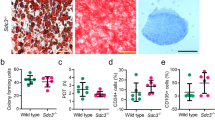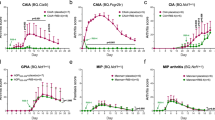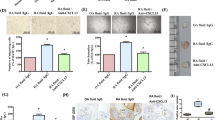Abstract
A ubiquitous cell adhesion receptor, CD44, preferentially binds hyaluronan, a poly-saccharide macromolecule that is present in most extracellular matrices. Hyaluronan molecules have large hydrodynamic volumes that entrap substantial amounts of water and can therefore control tissue hydration (swelling). CD44 is overexpressed by synovial cells and leukocytes, and hyaluronan is overproduced in the rheumatoid synovium and in other inflammatory sites. Nevertheless, the role of the CD44–hyaluronan interaction during inflammation is unclear. Our evidence shows that the CD44 receptor plays a critical role in governing the migration of inflammatory leukocytes into the extravascular compartment of the synovium in murine arthritis. An anti-CD44 antibody induces a rapid loss of CD44 from both leukocytes and synovial cells and displays an inhibitory effect on cell–extracellular matrix interactions in the synovium. As a result, the administration of such an antibody abrogates tissue swelling and leukocyte infiltration, two major components of inflammation.
This is a preview of subscription content, access via your institution
Access options
Subscribe to this journal
Receive 12 print issues and online access
$209.00 per year
only $17.42 per issue
Buy this article
- Purchase on Springer Link
- Instant access to full article PDF
Prices may be subject to local taxes which are calculated during checkout
Similar content being viewed by others
References
Laurent, T.C. & Eraser, J.R. Hyaluronan FASEB J. 6, 2397–2404 (1992).
Aruffo, A., Stamenkovic, I., Melnick, M., Underbill, C.B. & Seed, B. CD44 is the principal Cell surface receptor for hyaluronate. Cell 61, 1303–1313 (1990).
Culty, M. et al. The hyaluronate receptor is a member of the CD44 (H-CAM) family of Cell surface glycoproteins. J. Cell Biol. 111, 2765–2774 (1990).
Underbill, C. CD44: The hyaluronan receptor. J. Cell Sci. 103, 293–298 (1992).
Toole, B.P. Proteoglycans and hyaluronan in morphogenesis and differentiation. in Cell Biology of ExtraCellular Matrix (ed. Hay, E.D.) 305–341 (Plenum, New York, (1991).
Lesley, J., Schulte, R. & Hyman, R. Binding of hyaluronic acid to lymphoid Cells lines is inhibited by monoclonal antibodies against Pgp-1. Exp. Cell Res. 187, 224–233 (1990).
Bartolazzi, A., Peach, R., Aruffo, A. & Stamenkovic, I. Interaction between CD44 and hyaluronate is directly implicated in the regulation of tumor development. J. exp. Med. 180, 53–66 (1994).
Thomas, L., Byers, H.R., Vink, J. & Stamenkovic, I. CD44H regulates tumor cell migration on hyaluronate-coated substrate. J. Cell Biol. 118, 971–977 (1992).
Herrlich, P., Zöller, M., Pals, S.T. & Ponta, H. CD44 splice variants: Metastases meet lymphocytes. Immun. Today 14, 395–399 (1993).
Günthert, U. CD44: A multitude of isoforms with diverse functions.[Review]. Curr. Topics Microbiol. Immun. 184, 47–63 (1993).
Mackay, C.R. et al. Expression and modulation of CD44 variant isoforms in humans. J. Cell Biol. 124, 71–82 (1994).
Stamenkovic, I., Aruffo, A., Amiot, M. & Seed, B. The hematopoietic and epithelial forms of CD44 are distinct polypeptides with different adhesion potentials for hyaluronate-bearing Cells. EMBO J. 10, 343–348 (1991).
Hathcock, K.S., Hirano, H., Murakami, S. & Hodes, R.J. CD44 expression on activated B Cells. Differential capacity for CD44-dependent binding to hyaluronic acid. J. Immun. 151, 6712–6722 (1993).
Günthert, U. et al. A new variant of glycoprotein CD44 confers metastatic potential to rat carcinoma cells. Cell 65, 13–24 (1991).
Engström-Laurent, A. & Hällgren, R. Circulating hyaluronic acid levels vary with physical activity in healthy subjects and in rheumatoid arthritis patients. Relationship to synovib's mass and morning stiffness. Arthritis Rheum. 30, 1333–338 (1987).
Pitsillides, A.A., Worrall, J.G., Wilkinson, L.S., Bayliss, M.T. & Edwards, J.C. Hyaluronan concentration in non-inflamed and rheumatoid synovium. Br. J. Rheumatol. 33, 5–10 (1994).
Haynes, B.F., Hale, L.P., Patton, K.L., Martin, M.E. & McCallum, R.M. Measurement of an adhesion molecule as an indicator of inflammatory disease activity. Up-regulation of the receptor for hyaluronate (CD44) in rheumatoid arthritis. Arthritis Rheum. 34, 1434–1443 (1991).
Nettelbladt, O., Tengblad, A. & Hällgren, R. Lung accumulation of hyaluronan parallels pulmonary edema in experimental alveolitis. Am. J. Physiol. 257, 379–384 (1989).
Campbell, R.D., Love, S.H., Whiteheart, S.W., Young, B. & Myrvik, Q.N. Increased hyaluronic acid is associated with dermal delayed-type hypersensitivity. Inflammation 6, 235–244 (1982).
Sanchez-Madrid, F., Simon, P., Thompson, S. & Springer, T.A. Mapping of anti-genie and functional epitopes on the α- and β-subunits of two related mouse glycoproteins involved in Cell interactions, LFA-1 and Mac-1. J. exp. Med. 158, 586–602 (1983).
Kakimoto, K. et al. The effect of anti-adhesion molecule antibody on the development of collagen-induced arthritis. Cell. Immun. 142, 326–337 (1992).
Camp, R.L., Scheynius, A., Johansson, C. & Puré, E. CD44 is necessary for optimal contact allergic responses but is not required for normal leukocyte extravasation. J. exp. Med. 178, 497–507 (1993).
Knudson, C.B. Hyaluronan receptor-directed assembly of chondrocyte periCellular matrix. J. Cell Biol. 120, 825–834 (1993).
Bazil, V. & Horejsi, V. Shedding of the CD44 adhesion molecule from leukocytes induced by anti-CD44 monoclonal antibody simulating the effect of a natural receptor ligand. J. Immun. 149, 747–753 (1992).
Mikecz, K., Kim, J.H., Cole, A.A., Pappas, S.G. & Giant, T.T. Differential distribution of Cell adhesion molecules in the synovium of mice with proteoglycan-induced arthritis. Arthritis Rheum. 37, S397 (1994).
Trowbridge, I.S., Lesley Schulte, R., Hyman, R. & Biochemical characterization and cellular distribution of a polymorphic, murtne cell-surface glycoprotein expressed on lymphoid tissues. Immunogenetics 15, 299–312 (1982).
Peach, R.J., Hollenbaugh, D., Stamenkovic, I. & Aruffo, A. Identification of hyaluronic acid binding sites in the extra Cellular domain of CD44. J. Cell Biol. 122, 257–264 (1993).
Miyake, K., Underbill, C.B., Lesley, J. & Kincade, P.W. Hyaluronate can function as a Cell adhesion molecule and CD44 participates in hyaluronate recognition. J. exp. Med. 172, 69–75 (1990).
Lesley, J. et al. Requirements for hyaluronic acid binding by CD44: a role for the cytoplasmic domain and activation by antibody. J. exp. Med. 175, 257–266 (1992).
Giant, T.T., Mikecz, K., Arzoumanian, A. & Poole, A.R. Proteoglycan-induced arthritis in BALB/c mice. Clinical features and histopamology. Arthritis Rheum. 30, 201–212 (1987).
Mikecz, K. & Giant, T.T. Migration and homing of lymphocytes to lymphoid and synovial tissues in proteoglycan-induced murine arthritis. Arthritis Rheum. 37, 1395–1403 (1994).
Courtenay, J.S., Dallman, M.J., Dayan, A.D., Martin, A. & Mosedale, B. Immunization against heterologous type II collagen induces arthritis in mice. Nature 282, 666–668 (1980).
Williams, J.M., Zurawski, J., Mikecz, K. & Giant, T.T. Functional assessment of joint use in experimental inflammatory murine arthritis. J. orthop. Res. 11, 172–180 (1993).
Giant, T.T., Mikecz, K. & Poole, A.R. Monoclonal antibodies to different protein-related epitopes of human articular cartilage proteoglycans. Biochem. J. 234, 31–41 (1986).
Brennan, F.R. et al. Presentation of cartilage proteoglycan to a T cell hybridoma derived from a mouse with proteoglycan-induced arthritis. Clin. exp. Immun. 100, 104–110 (1995).
Buzás, E., Mikecz, K., Brennan, F.R. & Glant, T.T. Mediators of autopathogenic effector cells in proteoglycan-induced arthritic and clinically asymptomatic BALB/c mice. Cell. Immun. 158, 292–304 (1994).
Cs-Szabó, G., Roughley, P.J., Plaas, A. & Giant, T.T. Large and small proteoglycans retained in osteoarthritic and rheumatoid articular cartilages. Arthritis Rheum. (in the press).
Giant, T. Concanavalin A-binding link protein in the proteoglycan aggregate of hyaline cartilage. Biochem. biophys. Res. Commun. 106, 158–163 (1982).
SAS Institute Inc. The ANOVA Procedure. in SAS User's Guide: Statistics; Version edn 5 (ed. SAS Institute Inc.) 113–137 (SAS Institute Inc., Cary, North Carolina, (1985).
Author information
Authors and Affiliations
Rights and permissions
About this article
Cite this article
Mikecz, K., Brennan, F., Kim, J. et al. Anti-CD44 treatment abrogates tissue aedema and leukocyte infiltration in murine arthrtis. Nat Med 1, 558–563 (1995). https://doi.org/10.1038/nm0695-558
Received:
Accepted:
Published:
Issue Date:
DOI: https://doi.org/10.1038/nm0695-558
This article is cited by
-
Plasma High Mobility Group Box 1 (HMGB1), Osteopontin (OPN), and Hyaluronic Acid (HA) as Admissible Biomarkers for Endometriosis
Scientific Reports (2019)
-
Transforming growth factor-β-mediated CD44/STAT3 signaling contributes to the development of atrial fibrosis and fibrillation
Basic Research in Cardiology (2017)
-
Disease-promoting and -protective genomic loci on mouse chromosomes 3 and 19 control the incidence and severity of autoimmune arthritis
Genes & Immunity (2012)
-
An easy method to detect the kinetics of CD44 antibody and its receptors on B16 cells using atomic force microscopy
Molecular Biology Reports (2011)
-
PF-03475952: a potent and neutralizing fully human anti-CD44 antibody for therapeutic applications in inflammatory diseases
Advances in Therapy (2010)



